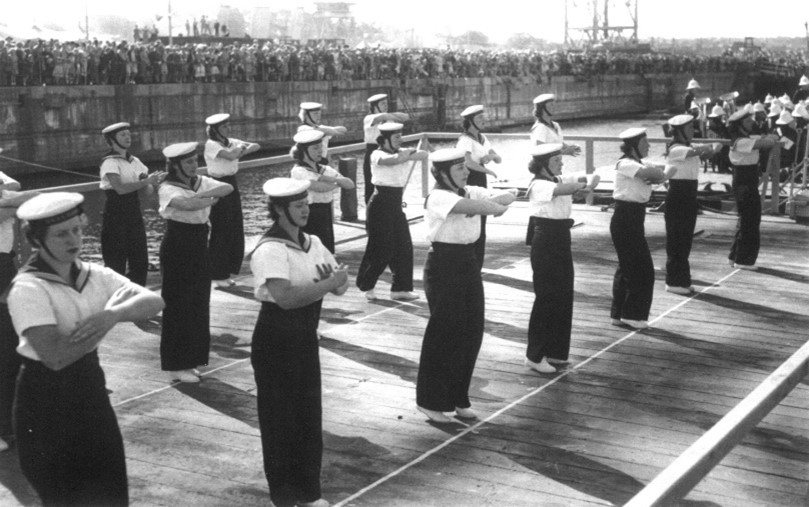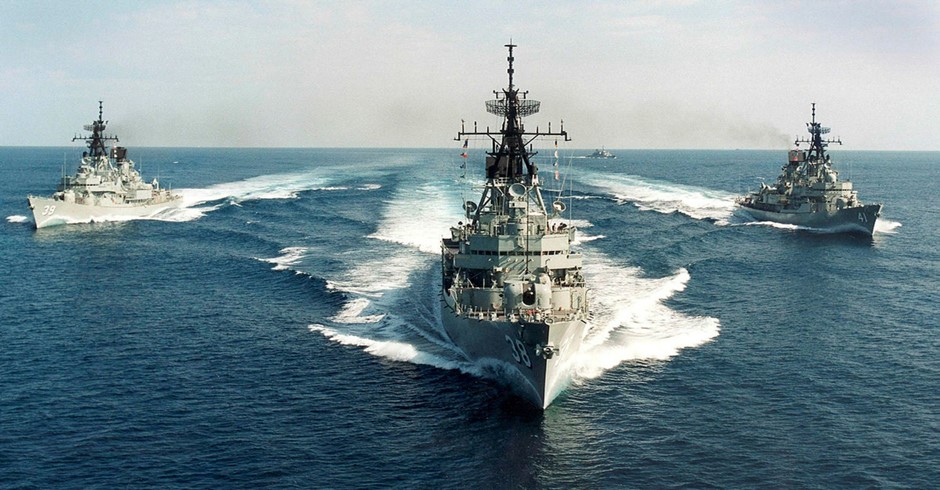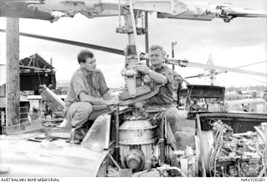The following is adapted from the Royal Australian Navy News, 17 April 1970 edition, page 4.
From1950 onwards the post-war tempo Naval growth quickened. The outbreak of the Korean hostilities in June 1950 intensified demands for naval forces.
Nine ships altogether were sent to operational theatres; Anzac, Tobruk, Bataan and Warramunga each having two tours of duty, while Sydney, Culgoa, Condamine, Murchison and Shoalhaven each made an operational tour.
RAN ships steamed some 463,000 miles and their man armament fired more than 26.000 rounds. RAN aircraft, dropped about 1000 bombs, fired over 300,000 rounds of 20 mm shells and launched many thousands of rockets. A total of 311 officers and 4196 ratings served in the area and thirty-two were awarded decorations. In addition, since the formation of the British Commonwealth Strategic Reserve, RAN ships, in rotation served continually from Singapore.
The decision to hold large-scale South East Asia Treaty Organisation (SEATO) maritime training exercises resulted in the grouping together of many ships and aircraft representing the interested nations. These exercises developed a high degree of efficiency in the combined fleets.
Changes within the structure of the Navy included the re-establishment of the Women’s Royal Australian Naval Service in 1950.

The first of the Daring Class Destroyers, HMAS Voyager, was launched in 1952 followed by her sister ships Vendetta and Vampire. Shropshire (1953) and Australia (1955) were handed over to the ship-breakers.
The angled-deck, steam catapult, mirror-landing Aircraft Carrier HMAS Melbourne commissioned in October 1955, and the Fireflies and Sea Furies were replaced by Gannets and the all-weather Sea-Venom jet fighter with helicopters acquired for air-sea rescue roles. The “Q” Class destroyers with the exception of Quality, were rebuilt as fast Anti-Submarine Frigates.
After 28 years at Flinders Naval Depot, the RAN College returned to Jervis Bay for the opening of the new scholastic year in 1958. Sir John Collins retired as First Naval Member in 1955 being succeeded by Sir Roy Dowling, who, in turn was succeeded by Sir Henry Burrell in 1959. In November 1960, the Government announced that the Royal Australian Navy would acquire six modern minesweepers; that a new survey ship would be constructed; and that a force of anti-submarine helicopters would be obtained. HMAS Melbourne would become an anti-submarine helicopter carrier after 1963.
1960-to 1970
During this decade, the RAN continued to expand with new ships being added to the Fleet with more on order. Similar to the previous decade hostilities (Confrontation and Vietnam War) intensified demands for more naval forces. On entering the “seventies,” the strength of the Navy was as follows:
- An anti-submarine aircraft carrier, HMAS Melbourne, flagship of the fleet, equipped with Wessex anti-submarine helicopters, Skyhawk fighter-bombers and Tracker anti-submarine aircraft.
- Three guided missile destroyers – HMAS Perth, Hobart and Brisbane, armed with two 5in. gun mountings Tartar sea-to air and Ikara anti-submarine guided weapon systems.
- Three Daring Class destroyers, HMAS Vampire, Vendetta and Duchess, armed with 4.5in gun mountings and anti-submarine mortars.
- Five destroyer escorts, HMAS Yarra, Parramatta, Stuart, Derwent, and Swan, which had Ikara anti-submarine missile systems.
- One oiler, HMAS Supply; one destroyer tender, HMAS Stalwart; and the fast military transport, HMAS Sydney.
- Two training ships, HMAS Anzac and HMAS Queenborough, the survey vessels HMAS Moresby and Diamantia and several small vessels with various roles.
- Twenty patrol boats, five for the Papua New Guinea coastal security force and the remainder for the RAN.
- The arrival of the Oberon Class submarines, HMAS Oxley, Otway, Ovens and Onslow after passage from the UK, saw the reformation of the Australian Submarine Squadron for the fourth time.
All guided missile destroyers, Hobart (3 times), Perth (twice) and Brisbane (once) and the Daring Class destroyer, Vendetta (once) served with the US Seventh Fleet off Vietnam and the troop transport, Sydney, made 25 “ferry runs” to the war zone with Army personnel.
Between 1961 and 1968, 43 ships were commissioned or re-commissioned:
- TYPE 12 FRIGATES: Derwent (30.4.64), Parramatta (14.7.1961), Stuart (28.6.63), Swan (20.10.70), Yarra (27.7.61).
- TON CLASS MINESWEEPERS/MINEHUNTERS (ex-RN): Curlew (21.8.62), Gull (19.7.62), Hawk (18.7.62), Ibis (7.9.62), Snipe (11.9.62), Teal (30.8.62).
- OBERON CLASS SUBMARINES: Onslow (3.12.68), Otway (23.4.68), Ovens (15.4.69), Oxley (21.3.67).
- SURVEY SHIPS: Moresby (6.3.64).
- PATROL CRAFT: Aitape (13.11.67), Acute (26.4.68), Adroit (17.8.68), Advance (24.1.68), Archer (15.5.68), Ardent (26.10.68), Arrow (3.7.68), Assail (12.7.68), Attack (17.11.67). Aware (21.6.68), Bandolier (14.12.68), Barbette (16.8.68), Barricade (26.10.68), Bombard (5.11.68). Buccaneer (11.1.69), Bayonet (22.2.69), Ladava (21.10.68), Lae (3.4.68), Madang (29.11.68), Samarai, (1.3.68).
- CHARLES F. ADAMS CEASS DESTROYERS (DDG’s): Brisbane (16:12.67). Hobart (18.12.65). Perth (17.7.65).
- REPLENISHMENT FLEET TANKER: Supply (Ex-Tide Austral) (15.8.62). Built for RAN, completed 1955 loaned to Admiralty 1955-62.
- ESCORT MAINTENANCE SHIP: Stalwart (9.2.68).
- DESTROYER: Duchess (Ex Royal Navy) (8.5.64).
- FAST TROOP TRANSPORT (converted from A/C): Sydney (7.3.62).
A further type 12 frigate, HMAS Torrens was launched in 1969. During the “sixties.” the aircraft carrier, HMAS Melbourne, was modernised to operate her “new teeth.” Skyhawk and Tracker aircraft, from the US.

Fleet Air Arm
The revitalised Fleet Air Arm was comprised of seven Naval Air Squadrons split into two groups — the Training Air Group (permanently based at Albatross), and the Carrier Air Group, which embarked in Melbourne. The squadrons, their aircraft and roles were as follows:
TRAINING AIR GROUP:
723 Squadron: Iroquois UH IB: Search and rescue training — Scout AH Mk. 1: Survey (HMAS Moresby)
724 Squadron: Vampire: Fleet requirements — Venom: Fleet requirements – — Skyhawk . A-4G: -Fighter, operational — Skyhawk TA-4G 1 (Trainer).
725 Squadron: Wessex Mark 31B: – Anti-submarine helicopter.
851: Squadron: Tracker S2E: : Fixed wing anti-sub— Dakota C47: Navigation Training-Communications.
CARRIER AIR GROUP:
805 Squadron: Skyhawk A4G Fighter.
816 Squadron: Tracker S2E: Fixed wing anti-submarine.
817 Squadron: Wessex 31B: Anti-submarine helicopters.
In October 1967 a unit of RAN pilots and. supporting personnel formed the RAN Helicopter Flight Vietnam, and served in the Vietnam war theatre with a US Army Assault Company. RAN pilots also served with the RAAF No. 9 Squadron in Vietnam. RAN Clearance Divers were also serving in Vietnam.





